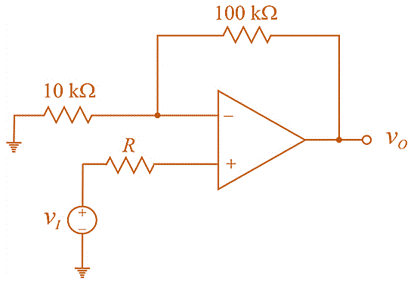
a.
Range of output voltage for the given specifications.
a.
Answer to Problem 14.51P
The range of output voltage is,
Explanation of Solution
Given:
The given circuit is shown below.

Input offset voltage is
Average input bias current is
Offset bias current is
Calculation:
As,
And
Adding (1) and (2)
From (1)
For
For
Now, the modified circuit with offset voltage and bias current is shown below.

KCL at non-inverting terminal,
Now, for ideal op-amp
Now, KCL at inverting terminal,
Putting
Now,
For
For
For
0So, the range of output voltage is,
b.
Range of output voltage for the given specifications.
b.
Answer to Problem 14.51P
The range of output voltage is,
Explanation of Solution
Given:
The given circuit is shown below.

Input offset voltage is
Average input bias current is
Offset bias current is
Calculation:
From equation (4)
For
Putting the values,
For
For
So, the range of output voltage is,
c.
Range of output voltage.
c.
Answer to Problem 14.51P
The range of output voltage is,
Explanation of Solution
Given:
The given circuit is shown below.

Input offset voltage is
Average input bias current is
Offset bias current is
Calculation:
From equation (4)
For
Putting the values,
For
For
So, the range of output voltage is,
Want to see more full solutions like this?
Chapter 14 Solutions
Microelectronics: Circuit Analysis and Design
- For an ideal op-Amp differentiator circuit C = 10 uF and R = 10 kohm . If a triangular wave is fed through the input with a voltage rise of 5 V in 50 ms, what would be the magnitude of output voltage? None of the options are accurate Can't be determined from the given information 5 V peak square signal 1 mV peak square signal 10000 mV square signal 100 V peak square signal 1 V peak square signal 0.1 V peak square signalarrow_forwardC'uk Converter Design A C'uk converter has an input of 12 V and is to have an output of - 24 V supplying a 60 W load. Select the duty ratio, the switching frequency, the inductor sizes such that the change in inductor currents is no more than 12 percent of the average inductor current, the output ripple voltage is no more than 1.5 percent, and the ripple voltage across C1 is no more than 3 percent.arrow_forwardA boost regulator has L=0.15 mH and C=0.11 mF with a duty cycle of 0.66 at a switching frequency of 50 kHz. The average load current is la=0.5A. The maximum ripple output voltage is: Select one: a. None of these b. 1.6V C. 2.6V d. 0.6Varrow_forward
- if you design differentiator to differentiate input signal varies in frequency between 1 KHz and 20 KHz then find. Cutoff frequency=.......... 01000 O2000 03000 O4000arrow_forward4. An RC filter stage (R = 33 02, C = 120 µF) is used to filter a signal of 24 V dc with 2 V rms operating from a full wave rectifier. Calculate the percentage ripple at the output of the RC Section for a 100-mA load. Also calculate the ripple of the filtered signal applied to the RC stage.arrow_forwardIf the load current is 5 mA and the filter capacitance is 1000uF, what is the peak- to-peak ripple out of a bridge rectifier? * 21.3 pv 56.3 nV O 21.3 mv O 41.7 mvarrow_forward
- Q2 In step-down regulator in Figure below, calculate the output voltage if the switching frequency is 76.923 kHz and the capacitor discharging time is 7 us. What happen to the output voltage if the discharging time of the capacitor increased to 9 us? Variable pule-width modulutor Comparator Enor signal Vaarrow_forwardDesign a Cuk converter that has an input of 25V and the output of -30V. The load is 60W. Specify the duty ratio, switching frequency, inductor values and capacitor values. The maximum change in inductor currents must be 20 percent of the average currents. The ripple voltage across capacitor C1 must be less than 5 percent, and the output ripple voltage must be less than 1 percent.arrow_forwardCalculate current gain, input and output impedance, and linearity. Beta = 90 IS = 2E-15arrow_forward
- 2. For the below figure - a) Derive the output and minimize the output function using Karnaugh map b) Draw the wave form of output if Barrow_forwardA buck converter operating in continues mode has the following parameters: Imin =0.9 A, Pout 124 W, R=2.6 2, f= 250 Hz, and the average value of the input current = 1.8 A. %3D %3D Find The inductor L in mH.arrow_forward2- For the circuit given below : Vin is a sine wave Vinpp=9 V and Vref=2.4 V , Assume Vsat=±12V Name the circuit and draw the input and output waveforms . Vo Vin Vref +arrow_forward
 Introductory Circuit Analysis (13th Edition)Electrical EngineeringISBN:9780133923605Author:Robert L. BoylestadPublisher:PEARSON
Introductory Circuit Analysis (13th Edition)Electrical EngineeringISBN:9780133923605Author:Robert L. BoylestadPublisher:PEARSON Delmar's Standard Textbook Of ElectricityElectrical EngineeringISBN:9781337900348Author:Stephen L. HermanPublisher:Cengage Learning
Delmar's Standard Textbook Of ElectricityElectrical EngineeringISBN:9781337900348Author:Stephen L. HermanPublisher:Cengage Learning Programmable Logic ControllersElectrical EngineeringISBN:9780073373843Author:Frank D. PetruzellaPublisher:McGraw-Hill Education
Programmable Logic ControllersElectrical EngineeringISBN:9780073373843Author:Frank D. PetruzellaPublisher:McGraw-Hill Education Fundamentals of Electric CircuitsElectrical EngineeringISBN:9780078028229Author:Charles K Alexander, Matthew SadikuPublisher:McGraw-Hill Education
Fundamentals of Electric CircuitsElectrical EngineeringISBN:9780078028229Author:Charles K Alexander, Matthew SadikuPublisher:McGraw-Hill Education Electric Circuits. (11th Edition)Electrical EngineeringISBN:9780134746968Author:James W. Nilsson, Susan RiedelPublisher:PEARSON
Electric Circuits. (11th Edition)Electrical EngineeringISBN:9780134746968Author:James W. Nilsson, Susan RiedelPublisher:PEARSON Engineering ElectromagneticsElectrical EngineeringISBN:9780078028151Author:Hayt, William H. (william Hart), Jr, BUCK, John A.Publisher:Mcgraw-hill Education,
Engineering ElectromagneticsElectrical EngineeringISBN:9780078028151Author:Hayt, William H. (william Hart), Jr, BUCK, John A.Publisher:Mcgraw-hill Education,





